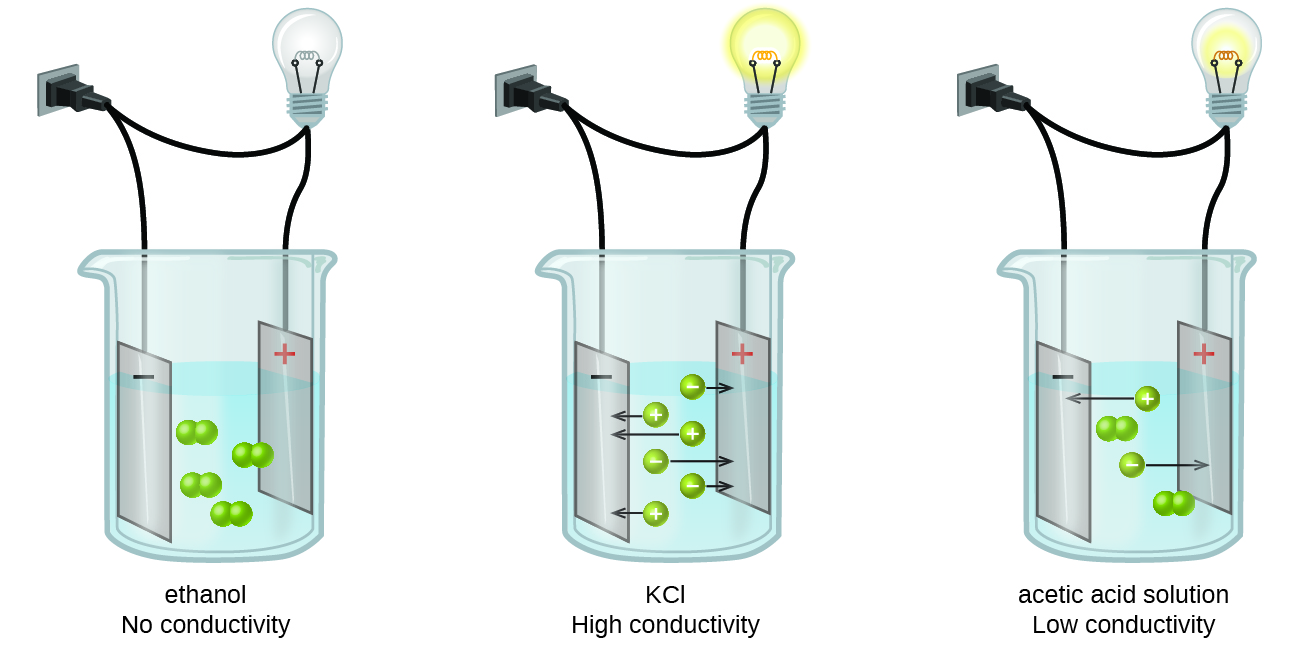9.4.2: Electrolytes and Nonelectrolytes
- Page ID
- 367837
- Define electrolytes and non electrolytes
- Discuss the idea of water as the "universal solvent".
- Explain how water molecules attract ionic solids when they dissolve in water.
When some substances are dissolved in water, they undergo either a physical or a chemical change that yields ions in solution. These substances constitute an important class of compounds called electrolytes. Substances that do not yield ions when dissolved are called nonelectrolytes. If the physical or chemical process that generates the ions is essentially 100% efficient (all of the dissolved compound yields ions), then the substance is known as a strong electrolyte (good conductor). If only a relatively small fraction of the dissolved substance undergoes the ion-producing process, the substance is a weak electrolyte (does not conduct electricity as well).
Substances may be identified as strong, weak, or nonelectrolytes by measuring the electrical conductance of an aqueous solution containing the substance. To conduct electricity, a substance must contain freely mobile, charged species. Most familiar is the conduction of electricity through metallic wires, in which case the mobile, charged entities are electrons. Solutions may also conduct electricity if they contain dissolved ions, with conductivity increasing as ion concentration increases. Applying a voltage to electrodes immersed in a solution permits assessment of the relative concentration of dissolved ions, either quantitatively, by measuring the electrical current flow, or qualitatively, by observing the brightness of a light bulb included in the circuit (Figure \(\PageIndex{1}\)).

Water and other polar molecules are attracted to ions, as shown in Figure \(\PageIndex{2}\). The electrostatic attraction between an ion and a molecule with a dipole is called an ion-dipole attraction. They are similar to the dipole-dipole interactions which were discussed earlier, but often stronger due to the full charge on the ions. These interactions are strong enough to play an important role in the dissolution of ionic compounds in water.

When ionic compounds dissolve in water, the ions in the solid separate and disperse uniformly throughout the solution because water molecules surround and solvate the ions, reducing the strong electrostatic forces between them. This process represents a physical change known as dissociation. Under most conditions, ionic compounds will dissociate nearly completely when dissolved, and so they are classified as strong electrolytes.
Which compound(s) will dissolve in solution to separate into ions?
- \(\ce{LiF}\)
- \(\ce{P_2F_5}\)
- \(\ce{C_2H_5OH}\)
Solution
\(\ce{LiF}\) will separate into ions when dissolved in solution, because it is an ionic compound. \(\ce{P_2F_5}\) and \(\ce{C_2H_5OH}\) are both covalent and will stay as molecules in a solution.
Which compounds will dissolve in solution to separate into ions?
- C6H12O11, glucose
- CCl4
- CaCl2
- AgNO3
- Answer
- c & d
Contributions & Attributions
This page was constructed from content via the following contributor(s) and edited (topically or extensively) by the LibreTexts development team to meet platform style, presentation, and quality:
Henry Agnew (UC Davis)


